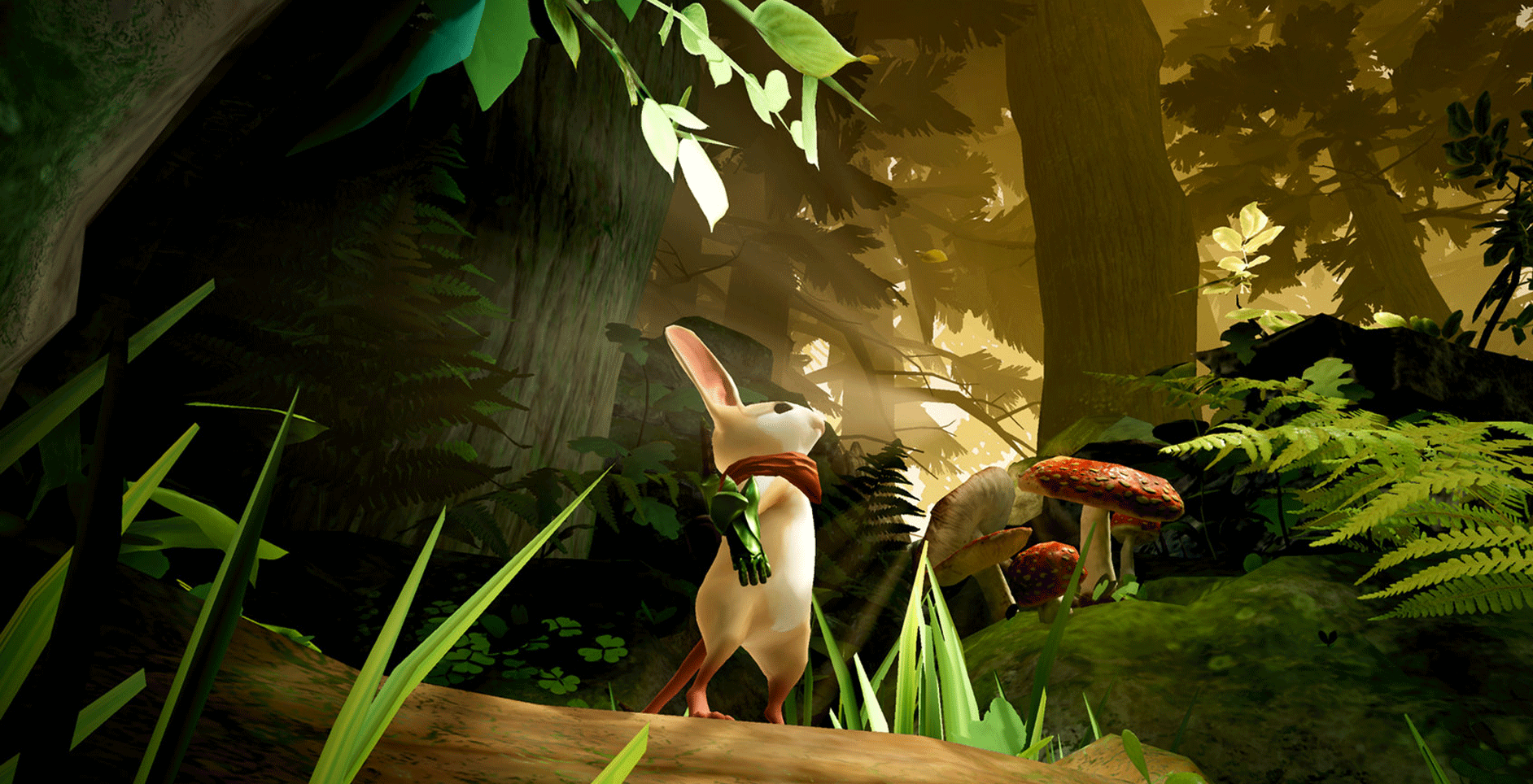When first announced at E3 2017, Moss intrigued me. It wasn’t a port, a sequel, or a weird fishing spin-off. It was an original tale that looked cute but different, drawing inspiration from games like Zelda but also trying to do it’s own thing. I’d previously thought that VR was only truly effective when played from the first person, but Moss proves that this isn’t necessarily the case, but with some minor caveats.
In Moss, you’ll play as The Reader, a strange being who exists outside of the story but is able to interact with the characters and scenery within. As such, most of the games story is presented to you as a picture book, with you flipping the pages as a pleasantly voiced narrator sets the scene. It’s a simple yet charming story that sees a village destroyed by a fire breathing snake named Sarffog. As The Reader, you’ll guide a young mouse named Quill. Quill’s uncle was kidnapped in the attack, but she herself evaded Sarffog’s forces. It’s a very simple story with little to no surprises but there’s something oddly compelling about it. So much so that I finished the game in a single sitting. Perhaps the standout element from Moss is your interactions with Quill herself. A jolly little creature, Quill will look to you after you complete a puzzle and give you thumbs up. She’ll turn around and look for your approval and motion to give her a high five after a difficult bout or you can even lean in close to startle her. She’s by no means the most realistic character I’ve ever met in a game but the way she interacts with you through the journey really helps make you care about her in the short amount of time you’ll spend with her.
Perhaps the standout element from Moss is your interactions with Quill herself. A jolly little creature, Quill will look to you after you complete a puzzle and give you thumbs up. She’ll turn around and look for your approval and motion to give her a high five after a difficult bout or you can even lean in close to startle her. She’s by no means the most realistic character I’ve ever met in a game but the way she interacts with you through the journey really helps make you care about her in the short amount of time you’ll spend with her.
As a game, Moss is a third person platformer with heavy puzzle elements and some light combat components thrown in for good measure. Played exclusively in VR, you’ll take the Reader’s perspective and harness their strange power with the DualShock controller. Every location is presented as a sort of diorama – you’ll be able to interact with certain objects or even stand up and peek around to see any areas the camera may be hiding. It feels like a bit of a gimmick at first, a shoehorned reason to require VR, but it leads to some nicely designed perception-based puzzles as you progress later. You’ll directly control Quill herself, and she controls well. The analog sticks move her wherever you want, and she can either jump or shimmy across gaps not unlike Nathan Drake or Lara Croft. The platforming itself is fine, if not simplistic, but also frustrating at times. Falling victim to the same issues that games like Tomb Raider and Uncharted did, it can be hard to discern which ledges are grabbable and aren’t, leading to some frustrating deaths here and there. Thankfully, Moss has a checkpoint system that’s incredibly forgiving, so not all is lost if you stuff up a jump, even if it’s not necessarily your fault.
You’ll directly control Quill herself, and she controls well. The analog sticks move her wherever you want, and she can either jump or shimmy across gaps not unlike Nathan Drake or Lara Croft. The platforming itself is fine, if not simplistic, but also frustrating at times. Falling victim to the same issues that games like Tomb Raider and Uncharted did, it can be hard to discern which ledges are grabbable and aren’t, leading to some frustrating deaths here and there. Thankfully, Moss has a checkpoint system that’s incredibly forgiving, so not all is lost if you stuff up a jump, even if it’s not necessarily your fault.
While you’re controlling Quill, you’ll also be able to use the Reader’s power to reach into each level to manipulate or adjust certain objects. Most of these objects are handily highlighted with a specific pattern or glow, and their usefulness is usually laid out quite well. You might lift a platform to help Quill cross a gap or drag a statue to a switch to weigh it down or even control an enemy to activate a switch that Quill herself can’t reach. The idea behind the Reader’s power is simple yet elegant, and really helps save Moss from being a done-to-death platformer. But it’s unfortunately weighed down by the limitations of the control scheme. It’s a problem with many facets – the Move Motion controllers would provide better tracking and movement recognition but provide a movement system that is less satisfying. The DualShock allows for greater control of Quill herself but is only being tracked by the Playstation Camera when the light bar is pointed directly at it. If you’re reaching in or pushing an object deeper in the screen, the light bar is bound to disappear from the cameras view and the tracking to glitch out. During the moments of the game where speed and accuracy matter, it’s incredibly frustrating to be wrestling with the controls and ultimately dying pointless deaths because of poor tracking.
But it’s unfortunately weighed down by the limitations of the control scheme. It’s a problem with many facets – the Move Motion controllers would provide better tracking and movement recognition but provide a movement system that is less satisfying. The DualShock allows for greater control of Quill herself but is only being tracked by the Playstation Camera when the light bar is pointed directly at it. If you’re reaching in or pushing an object deeper in the screen, the light bar is bound to disappear from the cameras view and the tracking to glitch out. During the moments of the game where speed and accuracy matter, it’s incredibly frustrating to be wrestling with the controls and ultimately dying pointless deaths because of poor tracking.
The combat itself is simple fare, playing like a simplified version of Zelda sans the lock-on. Quill can attack with her sword in a small combo, dodge enemy attacks and perform aerial attacks if she has the right vantage point too. Combat in Moss is easy, and rarely poses a challenge to the player. And yet, despite only really featuring three enemy types, it still does a great job at breaking up the puzzles and the exploration. The combat really shines when controlling Quill as she lures enemies into the path of a possessed enemy that you’re also controlling as the Reader. It sounds a little overwhelming, but tracking issues aside, it’s remarkable how Moss makes multi-tasking so effortless. The whole game is rather effortless, in fact. Moss is one of those VR games that I’d argue almost anyone could play. It’s slower paced than most games, making it approachable to those prone to motion sickness. There’s some tense moments but it’s a generally relaxing experience that doesn’t demand much from you. So much so, in fact, that most players will be done with Moss in four to five hours. It’s not a bad thing, as VR games can easily overstay their welcome, but some may find it a little short for the price it’s presently being offered at. Especially given that this whole game is referred to as “Book 1” of Quills journey in the final moments.
The whole game is rather effortless, in fact. Moss is one of those VR games that I’d argue almost anyone could play. It’s slower paced than most games, making it approachable to those prone to motion sickness. There’s some tense moments but it’s a generally relaxing experience that doesn’t demand much from you. So much so, in fact, that most players will be done with Moss in four to five hours. It’s not a bad thing, as VR games can easily overstay their welcome, but some may find it a little short for the price it’s presently being offered at. Especially given that this whole game is referred to as “Book 1” of Quills journey in the final moments.
Without a doubt Moss is one of the best-looking VR games that I’ve played too. From a visual standpoint, the game is just a joy to look at, lacking any signs of the jagged edges that most lower resolution VR games tend to sport. This is a smooth looking and running game. Artistically, the game makes great use of the fact that Quill is a tiny mouse – you’ll be shocked the first time you see a deer emerge from the background of one level, and just realise how small you really are. Other times you’ll just be completely taken in by the locales, which are all brought to life with realistic rays of light or the flittering glow of magic, fire or insects. The music is also fantastic, adding atmosphere and a sense of whimsy without being intrusive.



